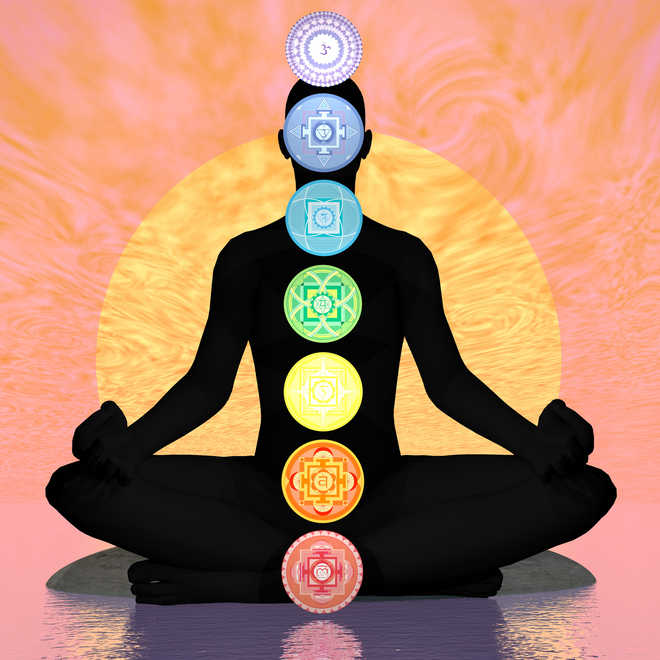Dr Satish K Kapoor
Kundalini is the primordial, invisible, formless, cosmic energy rolled up in three and a half coils, like the serpent in a slumberous state, near the lower end of brahma nadi, a neural pathway in sushumna.
Sushumna is the major nerve current which originates at muladhara chakra — abode of Shakti —in the lowest part of Meru, the vertebral column, and runs up the spine along with two other nadi-s - ida and pingala — to its left and rights sides, terminating at sahasrara chakra in the middle of cerebrum. At the top of Meru lies somarasa, the divine nectar, hidden in a hole, that is savoured by yogi-s during meditation. While ida and pingala is symbolised respectively as the rivers Ganga and Yamuna, sushumna is typified as the river Saraswati. When the three nerve currents meet, forming the triveni, the mind is uplifted to Kedar, the space between eyebrows — abode of Shiva.
Chakra-s (lit. wheels) are whirling energy-fields in the astral body. They are not visible to eyes, even with the support of advanced scientific instruments, but can be perceived during meditation. As kundalini strikes each, one after another, on its ascending journey to the higher spiritual regions, they bloom like lotuses (padma). The seven main chakra-s are: muladhara, svadhishthana, manipura, anahata, vishuddha, ajna and sahasrara, positioned respectively in the perineum, genitals, navel, heart, base of throat, centre of forehead and crown of the head. The first five are within sushumna; the remaining two in the head.
Muladhara chakra has in it the power of the earth element, svadhishthana, of the water element, manipura, of the fire element, anahata of the air element and vishuddha of the space element. They correspond respectively to five glands — gonads, adrenals, pancreas, thymus and thyroid. Ajna and sahasrara chakra-s, associated with pituitary and pineal glands are like neuro-transmitters and neuro-modulators that can bring about a physico-spiritual metamorphosis.
Shat chakra bhedana padyati, the method of piercing the chakra-s, from muladhara upwards, to awaken the kundalini, requires the observance of various disciplines and practices like, celibacy, silence, asana-s, postural devices, pranayama, rhythmic brething, bandha-s, body-locks, mudra-s, physico-mental postures, and chanting of mantras. By removing imbalances in chakra-s, one can revitalise them, linking the body and the mind to the cosmic forces, at a more refined wavelength.
As breath is the source of life, the kundalini is shaken from its state of hibernation, by uniting the two life-sustaining currents – the sun-breath (ha) which flows through the right nostril (pingala) and the moon-breath (tha) which flows through the left nostril (ida),– and making both of them pass through sushumna. When prana vayu, life-giving current in the heart, and apana vayu, downward breath in the region of anus, coalesce, and one is able to stop the flow of breath by practicing kumbhaka, the sleeping energy at muladhara chakra rises up, step by step, to sahasrara, the thousand-petalled lotus. But this is not the end of spiritual journey, as there are spiritual regions beyond.
The Hatha Yoga Pradipika ( III. 104-111) explains the method thus: ‘The sleeping she-serpent should be awakened by catching hold of her tail….She should be caught and moved daily, morning and evening for one and a half hours by filling air through pingala by the Paridhana method.’ By sitting in vajrasana and holding the feet firmly with hands, the position of kanda, between anus and the root of reproductive organ, just above muladhara chakra , comes near the ankle joint, where it should be pressed. The practitioner should perform bhastrika — inhale and exhale air quickly, like a pair of bellows – and contract the region of navel to move the kundalini so that it leaves ‘the entrance of sushumna at once and prana enters it of itself.’ When prana flows in sushumna and the mind is in shunyavastha, devoid of thought, the effect of past karma-s is dissolved (IV.12).
Raja yogi-s awaken the kundalini by moral restraints, will power, withdrawal of senses from their objects and concentration between two eyebrows; jnana yogis by deep study and rational inquiry into metaphysical questions; karma yogis by the power of righteous acts; bhaktas by faith, prayer, austerities, repetition of the holy name, devotional chanting and total surrender to god; and adherents of tantra by esoteric practices like, use of bija mantras (seed syllables), mandalas (mystic diagrams), panchamakaras (five M’s), etc.
Spiritual masters who can unlock the kundalini of a disciple by looking into his eyes, placing the thumb at his ajna chakra or a feet on his chest, dinning a mantra into his ear, or transmitting spiritual power just by thought, as in shaktipat, are rare these days.
Experiences during the awakening of the kundalini differ from person to person, due to variations in physical constitution, mental make-up and impressions of past lives. One may lose physical consciousness, have a burning or cold sensation, feel a sort of tickling in the spine, develop an uncontrollable sexual urge, emit blue/ white aura, perceive light, hear celestial sounds, become hypersensitive to smell, receive messages from the beyond, acquire siddhi-s, supernatural powers, conjure up memories of past lives, and so on.
(Dr Satish K Kapoor, former Principal, Lyallpur Khalsa College and former Registrar, DAV University, is a noted author, historian and spiritualist based in Jalandhar city)
Unlock Exclusive Insights with The Tribune Premium
Take your experience further with Premium access.
Thought-provoking Opinions, Expert Analysis, In-depth Insights and other Member Only Benefits
Already a Member? Sign In Now










